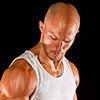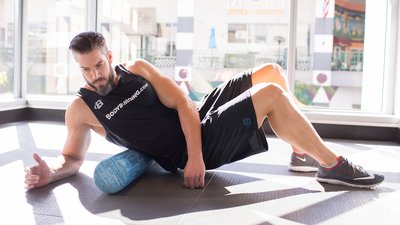Based on what you can see at the foam rolling station and cardio deck at any major commercial gym, it's clear that people have absolutely no idea how to prepare for training in the form of a dynamic warm-up. So they do…something, and call it good.
I get it: we all aren't exercise scientists. And the "something" method works OK for plenty of people. But guess what? You don't have to be a scientist to maximize your results in record time with your warm-up. And you can—and should—set your sights higher than OK!
Stop wasting away your precious training time on unproductive warm-ups! There's a right way to optimally prepare to train that will streamline your results while helping you bulletproof your body, and there's the wrong way that will leave you bored, fatigued, or burned out before your training even starts.
Start your next important lifting day with my highly effective and efficient six-phase warm-up system. I know six phases seems like a lot, but you'll be done in 10-12 minutes and ready to do your best work with the iron!
Phase 1: Targeted Soft Tissue Work
Not all foam rolling is equally effective, so if you plan on actually seeing objective benefits in your performance in the gym, while also mitigating the risk of training-related injuries, choose the correct soft tissue technique for the goal at hand.
Focusing on problematic "trigger points" is the most effective foam rolling method I've used for my athletes and clients to open up their mobility potential, while also being able to more reliably transfer into the big movement patterns.
Instead of rolling across the entire muscle belly, back and forth like a sloppy pizza roller, hunt just until you discover a trigger point—aka, the area in your armpit, chest, quad, or other muscle that simply feels like shit. You'll know it when you find it!
Fight the urge to foam roll your entire body and waste away precious training time by overdoing the first phase of this warm-up. Instead, prioritize one area, and invest 1-2 minutes total with acute trigger-point work on the ball or roller. If you want to hit other muscle groups later in the day, great—just follow the guide I laid out in my article "Most of You Are Foam Rolling Wrong. Here's How to Do It Right."
Remember, foam rolling isn't the goal itself, but rather a means to an end. Avoid becoming Gumby before training. Instead, focus on alleviating pain, improving mobility, and moving the hell on to more meaningful work.
Phase 2: Bi-Phasic Positional Stretching
Lifters and strength athletes cringe when they hear the word "stretching" in a dynamic warm-up. But contrary to popular belief, there's actually very little evidence that stretching negatively impacts power, strength, or performance in general.
And anyway, you're not going to be passively holding stretches for minutes at a time here, or using sloppy compensation patterns to try to "feel" individual muscles stretching. You're going to put your body into stabilized starting positions (I love half-kneeling, for instance), then generate internal tension throughout the body to wire stability through multiple joints. Then, you'll add a slight oscillation to enhance the stretch of the targeted tissues.
The "bi-phasic" part of this method just means that you'll follow up 30-45 seconds of oscillating back and forth with 15-30 seconds of end range stretching, which is still controlled by your muscular tension and body positioning. This stretching phase should take no more than 1-3 minutes to complete.
Both soft tissue work and bi-phasic stretching have the goal of tapping into the power of the parasympathetic nervous system (rest and recover) and allowing the human body to function as authentically as possible. That means you should be working on the same tissue in both Phase 1 and Phase 2 of this sequence for the best results. The two processes go hand in hand, as an integrated unit. If you're going to foam roll your quads, then stretch them this way afterward!
Phase 3: Corrective Exercise
The term "corrective" gets misused a lot these days. Personally, I don't subscribe to the idea that every movement or exercise must be perfect before adding load or intensity. Good enough is truly good enough when it comes to enhancing performance and reducing likelihood of injuries.
Adding to the confusion are the endless options in the corrective exercise library. We need to simplify our programming and focus in on key movements that are targeting linchpins of movement dysfunction or pain.
This doesn't have to be complicated! When in doubt, go for a single catch-all corrective exercise that touches on the hips, core, spine, and shoulders, helping reinforce quality movement. Dr. McGill's bird dog is a solid choice that far too many people mistakenly think is too easy for them.
If you, like many people, are at a loss trying to figure out if this stuff is actually working, I recommend just focusing on the three Ss of sound movement: stability, sequencing, and smoothness. Simply put, quality movement patterns or corrective movements should look effortless, smooth, and coordinated.
If yours aren't quite there yet, no worries. That's why it's worthy investing 1-2 minutes into this Phase 3 block every training day. It'll help you to reap the benefits of the warm-up, and help you maintain a functional and pain-free body.
Phase 4: Muscle and Pattern Activation
The goal everything you've done so far is to open up a movement pattern or region into new ranges of motion. But any improvements in range of motion are useless—and potentially dangerous—without being able to stabilize that new range of motion. That's where muscle and pattern activation comes into play.
Activation drills that actually produce results need to involve a high degree of mind-muscle connection, and even higher amounts of internal tension and force generation. In order to optimally "activate" a muscle, you need to be able to feel the muscle contract, then be able to carry over that feeling to a compound movement.
Again, this doesn't need to be complicated. I like the Rusin shoulder superset for the upper body, and the often-butchered glute bridge for the lower body.
No matter what movement you choose, thinking about squeezing the active muscles as hard as possible, hardwiring the connections of muscles moving and stabilizing into a new range.
A common problem with this phase is lifters annihilate muscles rather than activating them. This leads to fatigue and a drop in your performance during the workout. Limit yourself to 2-3 sets of 5-10 reps of each movement, with 15-30 seconds between sets. This works out to 1-2 minutes of investment into priming your powerhouse muscles in better, more usable ranges of motion.
Phase 5: Foundational Movement Pattern Development
The first four phases of this sequence are all precursors to this, the big movement patterns you'll be practicing in the fifth phase of this system. Everything you've done was important to get you to this point, but now is where your mind and muscle take over and get primed for performance.
Simply choose the pattern you'll be training as your big movement of the day. If it's squat day, then use the bodyweight squat. Bench press day? Hit the push-up. Simple, easy, effective.
As any serious lifter knows, it takes continuous tweaking and re-mastery of the big lifts in order to continue to see benefits without racking up injuries. So this phase allows us to step back and focus on the feel and quality of the foundational movement pattern at hand, without the stress of actually having maximum loading on the bar.
Why not just load up and go? Because you can't perfect your movement patterns during hard and heavy training. They need to be two separate entities.
That's why we use 2-3 sets of 3-5 slow, controlled, and deliberate bodyweight reps to grease the groove of the foundational movement pattern. The focus is not generating a training effect, but rather preparation.
This is definitely not wasted time! If you spend 2-3 minutes here, that time will pay off throughout the workout to come.
Phase 6: Central Nervous System Potentiation
You're almost ready. After spending some thoughtful practice on your foundational movement pattern of the day, it's time to cut fluff and focus on being an explosive and powerful athlete, with some central nervous system (CNS) stimulation.
There are only a few tried-and-true ways to potentiate the CNS to optimize power and strength. The first is maximum loading, which isn't an ideal fit for the warm-up. But the second, high-velocity-based movements, are the perfect fit for this pre-training preparation phase.
Here are some options:
- Lower body: Jumps or brief sprints
- Upper body: Medicine ball throws or slams
- Total body: Seal jacks
Similar to the foundational movement pattern prescription from the previous phase, look to match the type of CNS work with the big movement of the day. For squat-based movement days, pick a vertical jump for this phase. For a deadlift day, a broad jump or bound fits well. Bench press or back day? Medicine ball presses or slams are ideal. You can also implement neural primer supersets by combining jacks with jumps or throws, for the ultimate CNS priming response.
For CNS priming, it's crucial to dial back the total volume of work to avoid pre-fatigue of the CNS and peaking too soon before you get to use what you've worked so hard for! Stick to 2-3 sets of 2-5 reps of any of these methods, and no more than 15 total reps.
And then what? Go lift—and be surprised at how much better and stronger your training session feels!
Want to see more examples of how this warm-up looks in action? Check out this free e-book of the six-phase warm-up!

